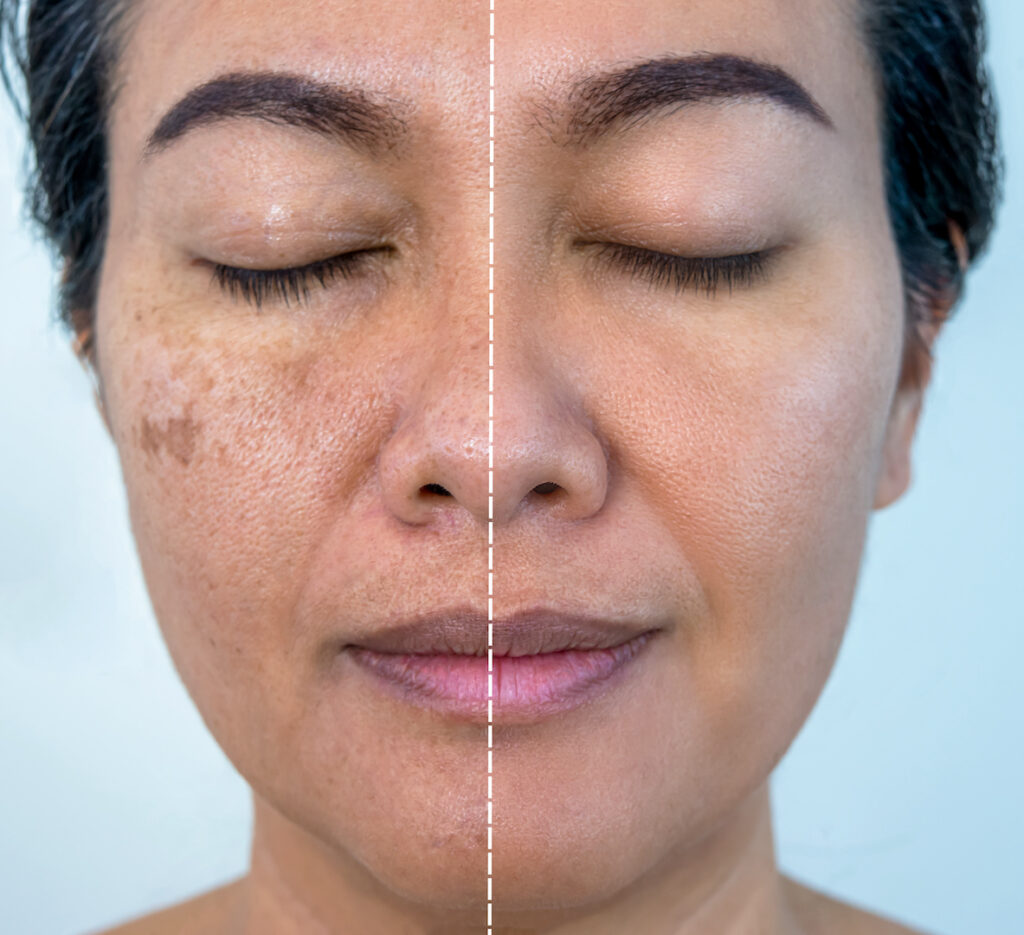
Melasma, or discoloration of the skin, is common condition, however it can be difficult to treat. Fortunately, there are several different ways to deal with melasma: with a good skincare routine, prescription medications, tretinoin, chemical peels, lasers, and RF microneedling.
What is Melasma?
Melasma is a type of hyperpigmentation or skin discoloration that appears as dark brown patches most often on the forehead, cheeks, nose, and upper lip. It is more prevalent in those with darker skin tones that tan easily, but almost all skin complexions can be affected. The American Academy of Dermatology Association reports that about 90% of those with melasma are women, usually between the ages of 20 and 40. The two main factors that contribute to melasma are hormonal changes like during pregnancy and exposure to UV light particularly during the summer months. Most cases of melasma are due to these two catalysts.
Hyperpigmentation particularly on the face can make patients feel self-conscious. Concern for better skin appearance often has patients with melasma looking for a way to get rid of it. The goals of treatment should be to:
- Decrease the amount of pigment the body makes
- Even out skin tone, to restore to its original color.
Advances in dermatology offer a host of solutions to deal with this skin condition. The following six ways can help to reduce its appearance.
Skincare Route: Hyperpigmentation can be treated by over-the-counter topical products that can prevent and fade it. One way to prevent melasma is with the use of sunscreen. The best defense is to apply a broad-spectrum mineral sunscreen with zinc or titanium every morning.
Melasma does respond to vitamin C, which also does double duty to protect the skin from UV damage. Vitamin C acts as an antioxidant to lighten dark spots and improve the skin’s appearance. It fights free radical damage and brightens the skin tone overall. Topical products that contain vitamin C come in a range of strengths and price points.
Prescription Medications: Exfoliation is the key for minimizing dark spots like melasma. When store brand topical treatments are not clearing up melasma, it may be time to try an exfoliator that penetrates deeper. Prescription strength medications can help to turn over the cells, produce collagen, and rejuvenate the skin.
Hydroquinone is a very effective skin-lightening agent but can only be used for short periods of time, for example three to six months. It works to even out the skin tone. A retinoid can also even out the skin tone and texture.
Tretinoin: Tretinoin (Retina-A) is an example of a prescription medicine has been a popular acne treatment for decades. But beyond its benefits as an acne treatment, tretinoin can also be an effective treatment for melasma. Tretinoin is a topical retinol which speeds up the rate at which cells turn over. If you suffer from dark spots that are not responding to over-the-counter treatments, a prescription for retinol might be more effective.
Chemical Peels: Chemical peels are another way to manage melasma. Research has indicated that chemical peels are a second line of management of melasma as they improve the epidermis. Chemical peels are skin resurfacing treatments in which a chemical mask is applied. The mask reacts with the dead skin cells on the outer layer of the skin to gently exfoliate the area. This triggers the healing response and encourages cell turnover for healthier skin.
Chemical peels are effective in treating melasma as they remove current discoloration on the skin as well as prevent the accumulation of melanin in the skin, which leads to further discoloration. As long as the sun is avoided, chemical peels can prevent melasma from occurring in the future.
Priming of the skin and the use of topical agents are needed to get the best results from peeling. Therefore, chemical peels are safe and effective when performed in the office of a medical professional. There are a wide variety of chemical peels that exfoliate the outer layer of skin and stimulate collagen production for a more youthful look.
Lasers: There are several types of lasers that can be used to treat melasma. They use energy to reduce melasma below the skin’s surface. Fractional lasers make microscopic holes in the skin to stimulate the growth of new and healthy skin cells. IPL (Intense Pulsed Light Laser) uses lights in different wavelengths to target the discoloration of the skin.
Laser treatment is for those who would like quick and long-term results, or when topical agents have not been effective. A 2017 study suggested that women who experience melasma during pregnancy and do not plan to become pregnant again are good candidates for laser treatment. Patients usually see improvement with the first session, but often need additional treatments to receive the best results.
RF Microneedling: RF (radiofrequency) microneedling is a treatment that evens out skin tone while boosting collagen production. RF microneedling uses an energy device that utilizes a grid of needles into the skin. Radiofrequency energy targets the dermis. This treatment has been effective in improving skin texture and diminishing fine lines and wrinkles and can improve melasma by distributing the pigment, so it is not as apparent.
RF microneedling requires minimal downtime and risk. Multiple sessions are usually required, with 4 to 12 weeks between sessions.
Reduce the Appearance of Melasma
BB Aesthetic Medical Spa offers a variety of ways to treat melasma and can discuss which option would be best for you. If you suffer from melasma and would like to get rid of it, contact us today.












